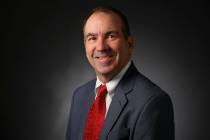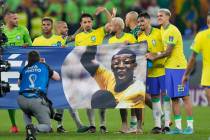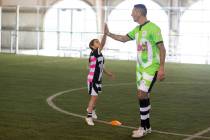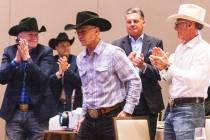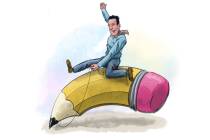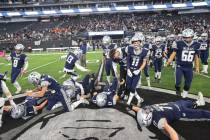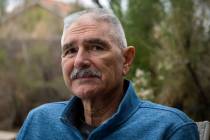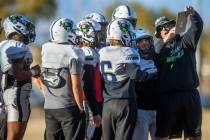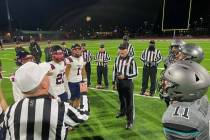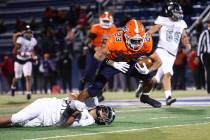Bull riders made eight seconds last 21 years
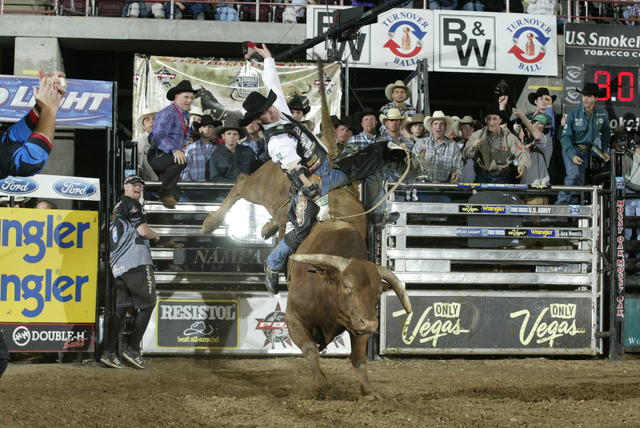
Here’s what usually happens when you break away from an established pro sports league and start your own pro sports league: You take a ride down the boulevard; you wind up with a broken dream. Then maybe 25 years later, ESPN does a documentary on the temerity of starting a pro league from scratch, and Bob Costas says it was fun, despite the empty seats.
You might even win an antitrust suit against the established league, and a jury might award you $1 in damages when you were seeking $567 million. Ask Donald Trump about the New Jersey Generals sometime.
That’s why the Pro Bull Riders, who are celebrating their 21st World Finals at the Thomas &Mack Center this week, are such an anomaly.
This is a league that has survived and thrived despite the most humble of origins: It started in a motel room in Scottsdale, Ariz., in 1992. Michael Gaffney doesn’t remember what motel. Knowing how rodeo cowboys are with their money, it was probably Motel 6.
Knowing how rodeo cowboys are with their money, “It was probably a room somebody had slept in the night before,” Gaffney said.
Gaffney was one of 12 bull riders who met in that motel room in Arizona, who felt the bull riders were subjecting themselves to an awful lot of bodily harm for only minuscule payouts as part of the Professional Rodeo Cowboys Association, when they were the featured attraction.
Hell, you couldn’t even get a broken nose fixed with what it paid to win in the PRCA. They don’t accept gold belt buckles in an emergency room.
So each of those cowboys wrote a check for $1,000, and threw it into a cowboy hat.
And thus began the PBR.
Gaffney says you don’t know how hard it was to throw that check into the hat.
Staying on top of Little Yellow Jacket the bad-ass bucking bull for eight seconds was much easier than parting with $1,000 won on the circuit, because bull riding ain’t like baseball or football — they don’t pay you in bull riding when you strike out or fumble.
Gaffney was 22 when the PBR formed. He had been PRCA rookie of the year in 1990; he won the average at the National Finals at the T&M in ’91. These had been outstanding years. And at the end of them, he might have broken even.
So when Ted Nuce and Cody Lambert and Bobby Delvecchio and Tuff Hedeman and the other veteran bull riders told Gaffney to write the check and put it in the hat, Gaffney wrote the check and put it in the hat.
Were there growing pains? Hell, yes, there were growing pains.
Gaffney remembers chairs being thrown (Lambert and Tuff) when the PBR directors met. He said after Randy Bernard came aboard as CEO, not as many chairs were thrown.
The bull riders had the … um, intestinal fortitude, and maybe some of them had the vision, but Bernard was the one who helped them realize the vision.
When he took over, the PBR had $8,000 in the bank, and $140,000 in the hole. The outstanding bill hole.
“One thing you really need to try to do is make sure we make $50,000, so you can get paid,” Cody Lambert told him.
Under Bernard’s leadership, a TV deal was developed, and a lot of marketing deals and truck sponsorships, and when Bernard told the bull riders there would come a day when they’d compete for a $1 million bonus in the finals in Las Vegas, the bull riders did not throw chairs. They about laughed him out of the room.
Then in 2003, Chris Shivers took home $1 million for winning in Las Vegas, and then none of the bull riders laughed at Randy Bernard anymore.
“For every 1,000 (crazy) ideas he had, he’d come up with one that was a doozy,” Gaffney said with the utmost respect for Randy Bernard’s vision and his truck sponsorships.
So now the bull riders compete for $2.2 million at the finals here, and there are action figures of the riders and the bulls, and last week, the riders and bulls competed on the beach at Huntington Beach, Calif., where surfboards were in the chutes.
How’s that for vision?
Most of the guys who ponied up $1,000 in Scottsdale in 1992 sold their stakes a few years back. They are millionaires now. Gaffney reinvested some of his shares. He still has a lot of square feet and square acres back at his place in Corrales, N.M., just outside of Albuquerque, despite putting his wife, Robyn, through medical school.
He also has a nasty scar on his right butt cheek from when a bull planted his horn five inches deep.
“We never compromised on what our goals were,” the 1997 series champion said of why the PBR has succeeded, whereas the ABA’s legacy is a red, white and blue basketball and Donald Trump had to ask for change for a dollar so the other United States Football League owners got paid.
“You’ve got two great athletes (bull rider and bull) going after each other. We never compromised that. We were able to put our egos and self-interests aside and said ‘We can make this work.’ ”
Gaffney retired from riding bulls shortly after staying aboard Little Yellow Jacket for a score of 96.5, tying the all-time PBR record, in Nampa, Idaho. He had gotten out relatively healthy, save for that scar on his rear end. Robyn gave him a bronzed statue commemorating that ride at his retirement party. It sits on a coffee table in their living room.
Pictures of Brent Thurman and Glen Keeley hang on the wall. Those guys were Michael Gaffney’s friends. They were killed riding bulls.
And now you know why those cowboys wrote checks for $1,000 in that Scottsdale, Ariz., motel room, and tossed them into a hat.
Las Vegas Review-Journal sports columnist Ron Kantowski can be reached at rkantowski@reviewjournal.com or 702-383-0352. Follow him on Twitter: @ronkantowski



